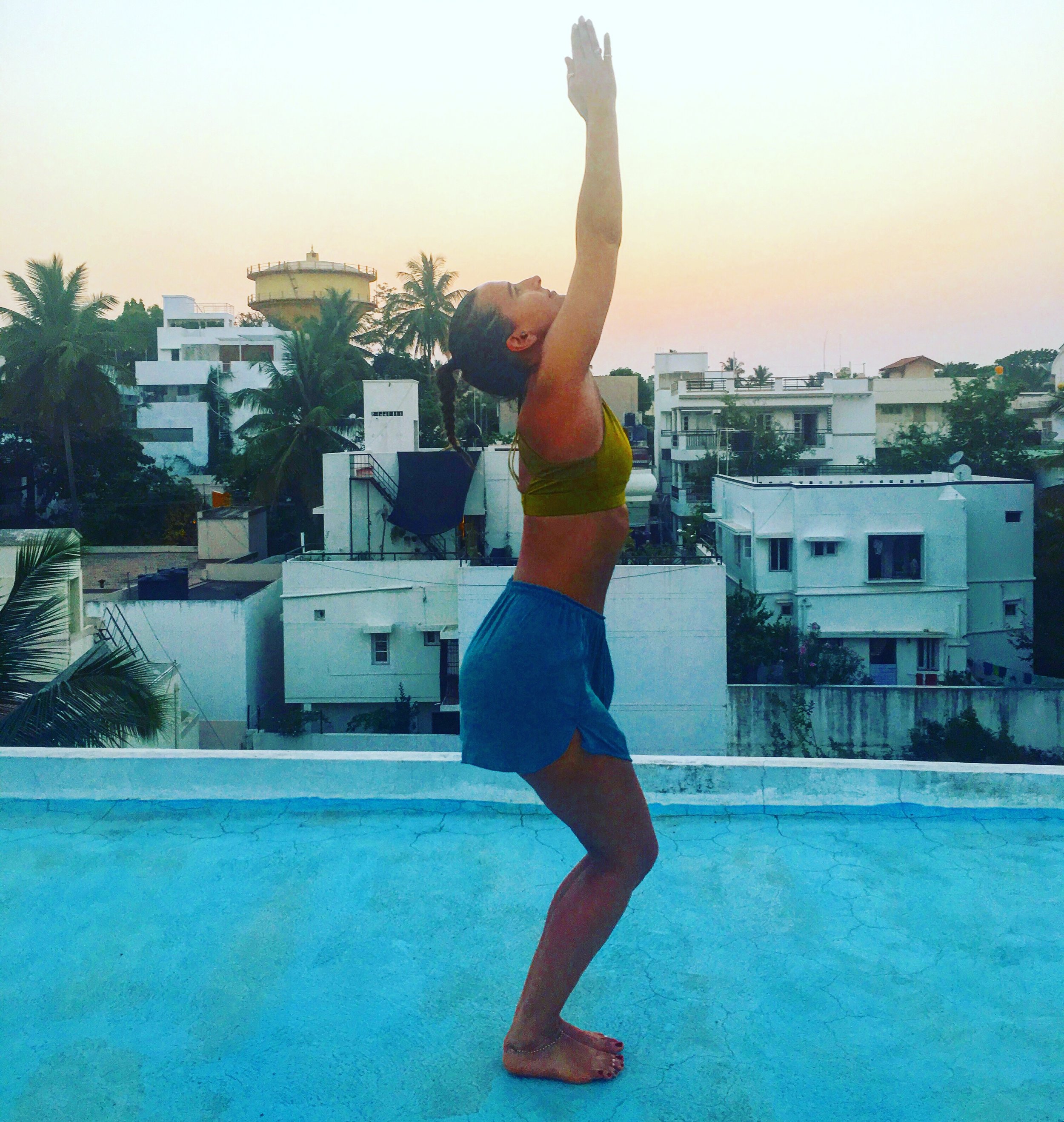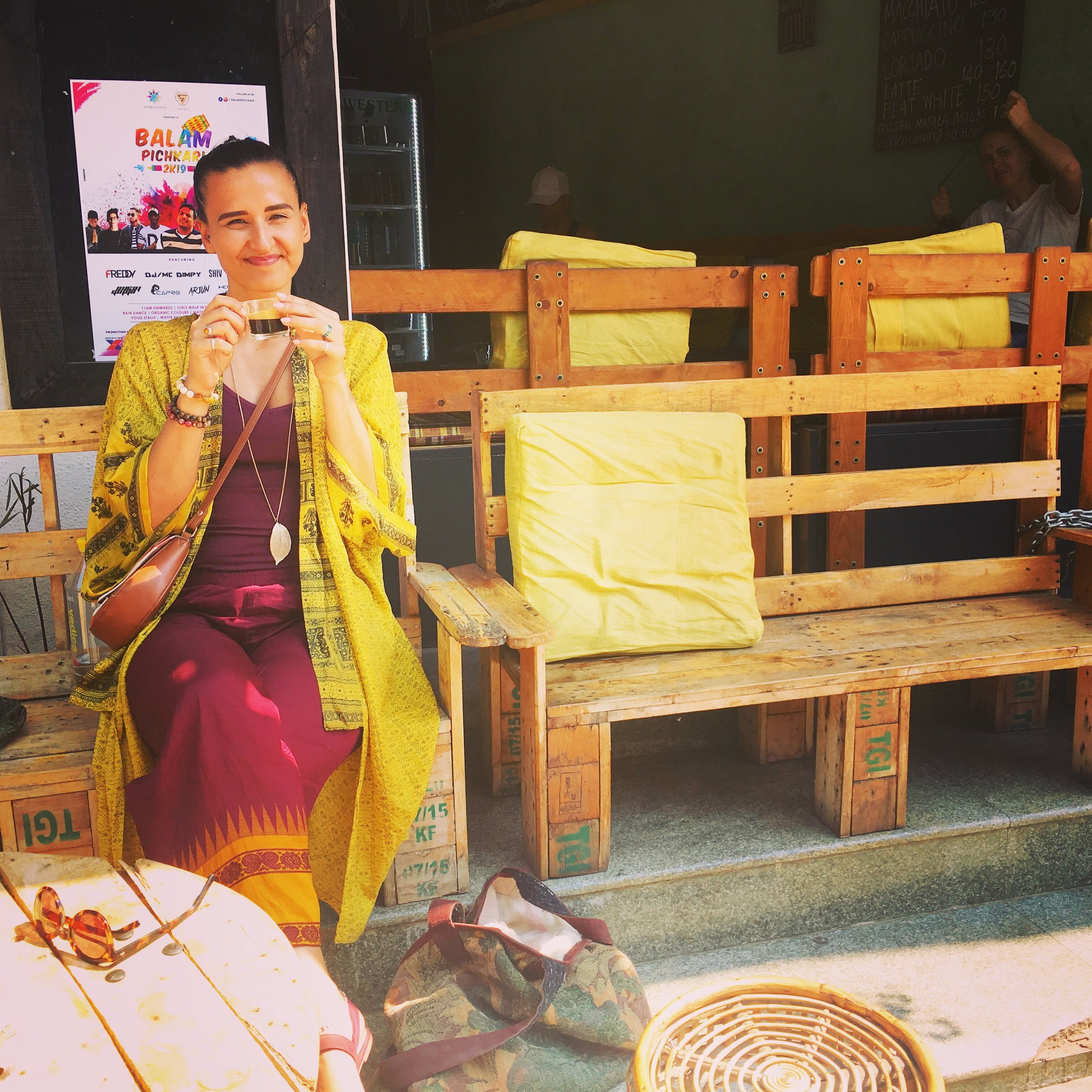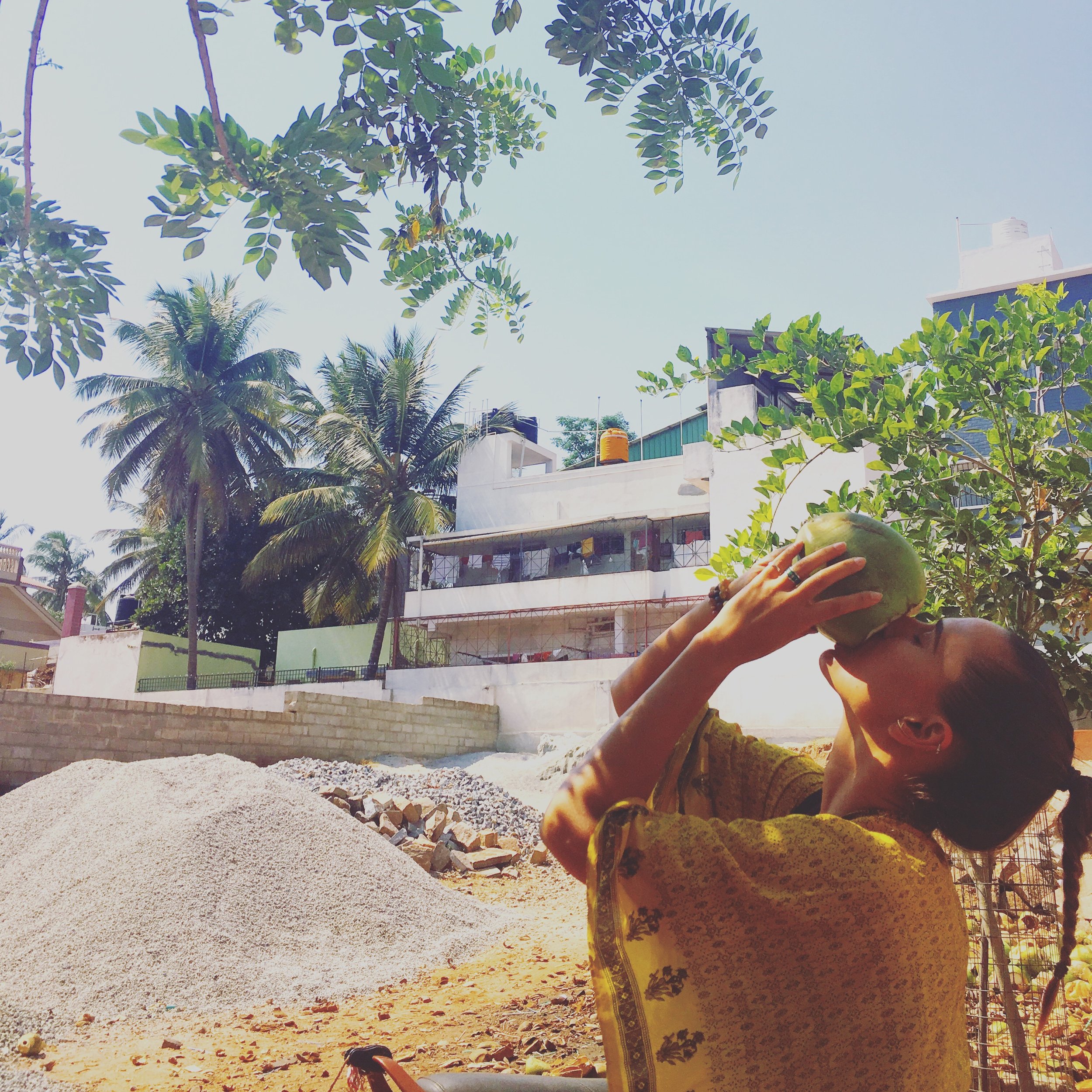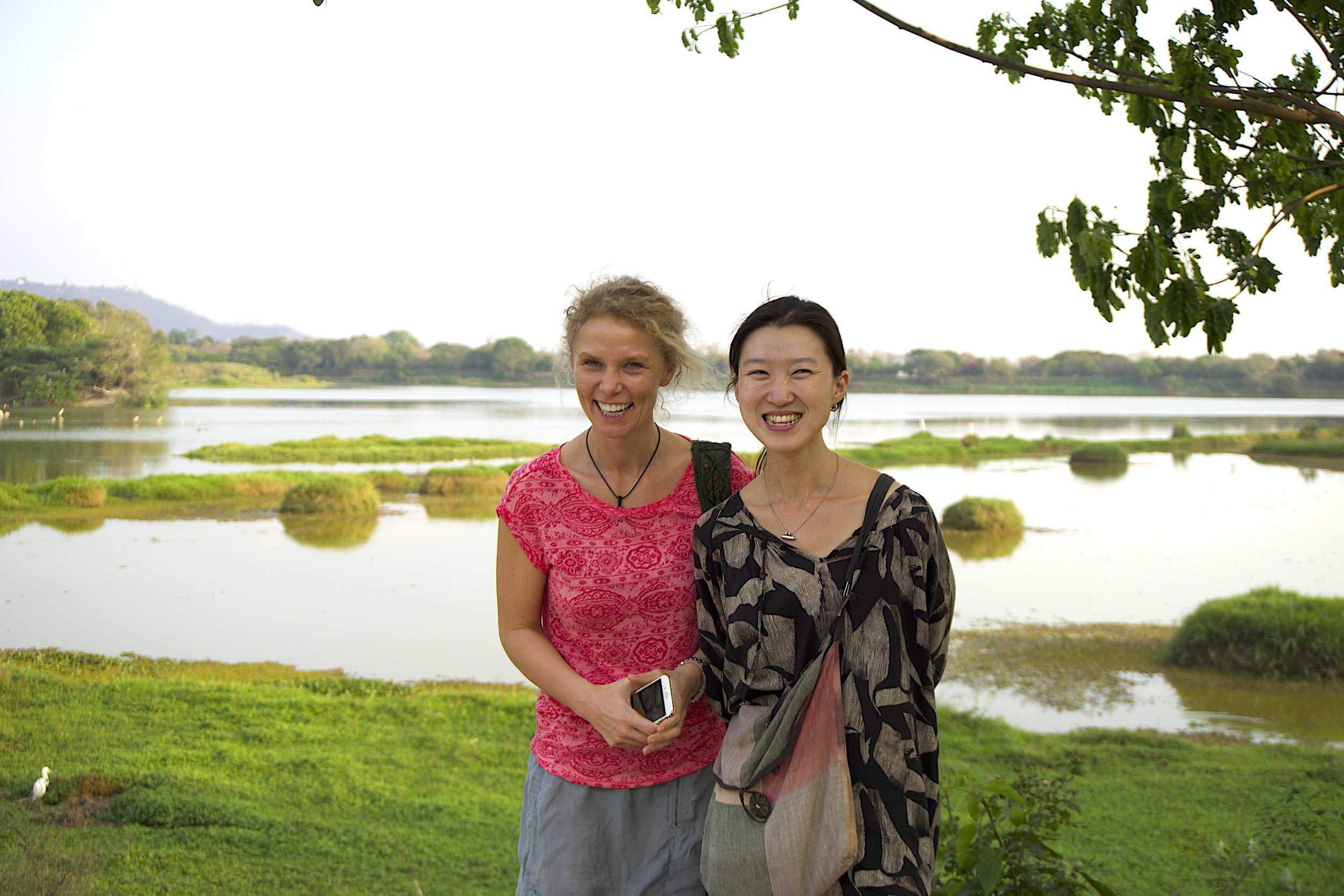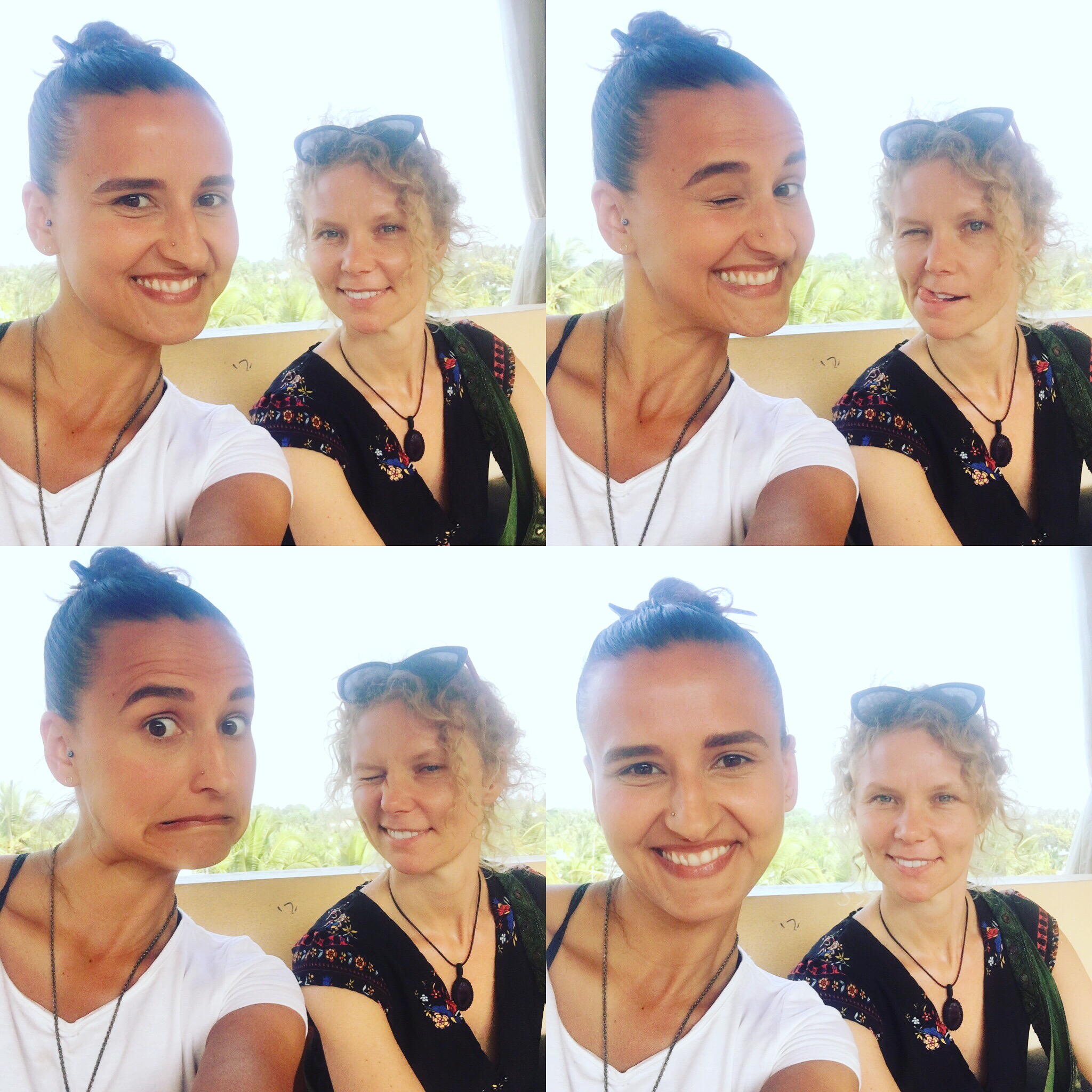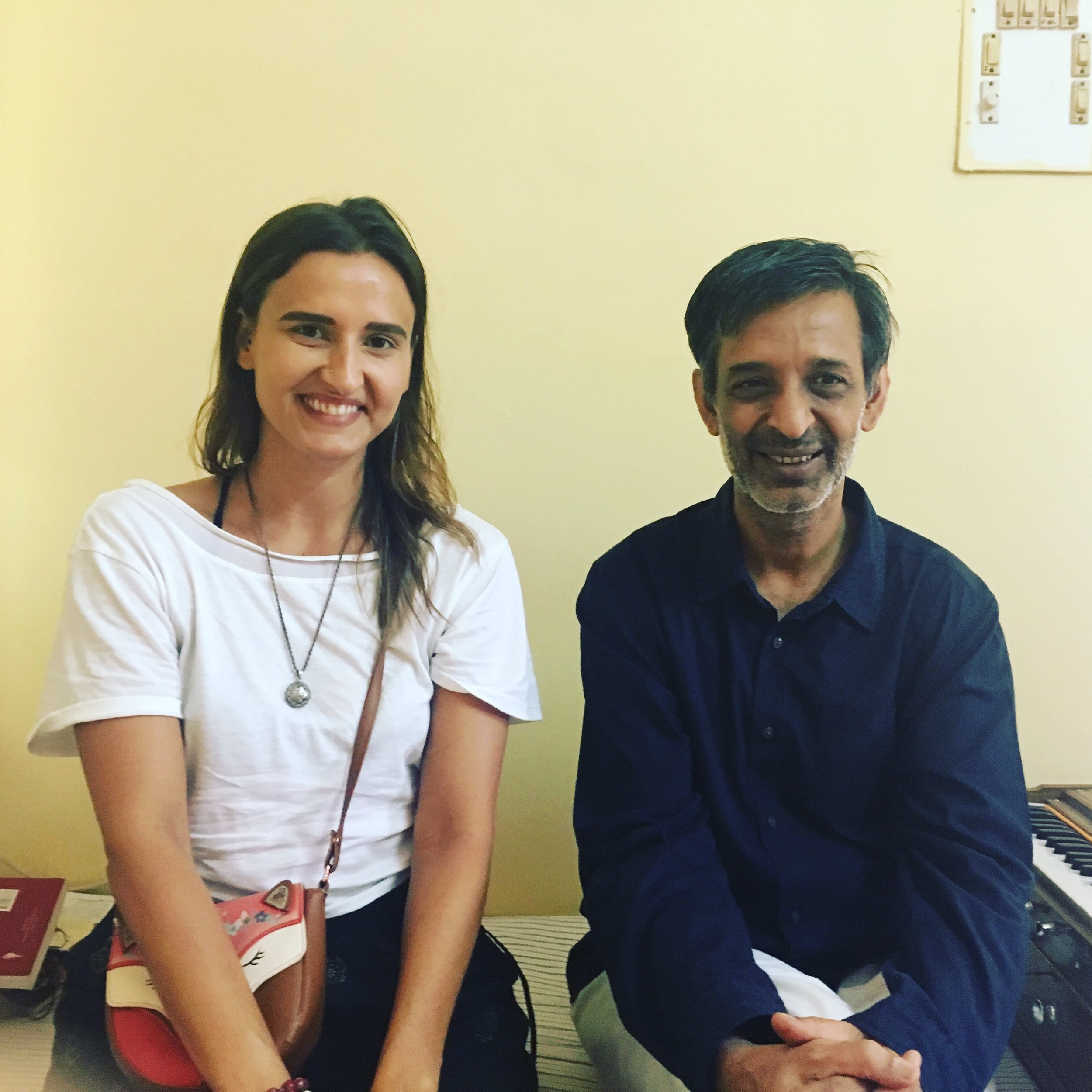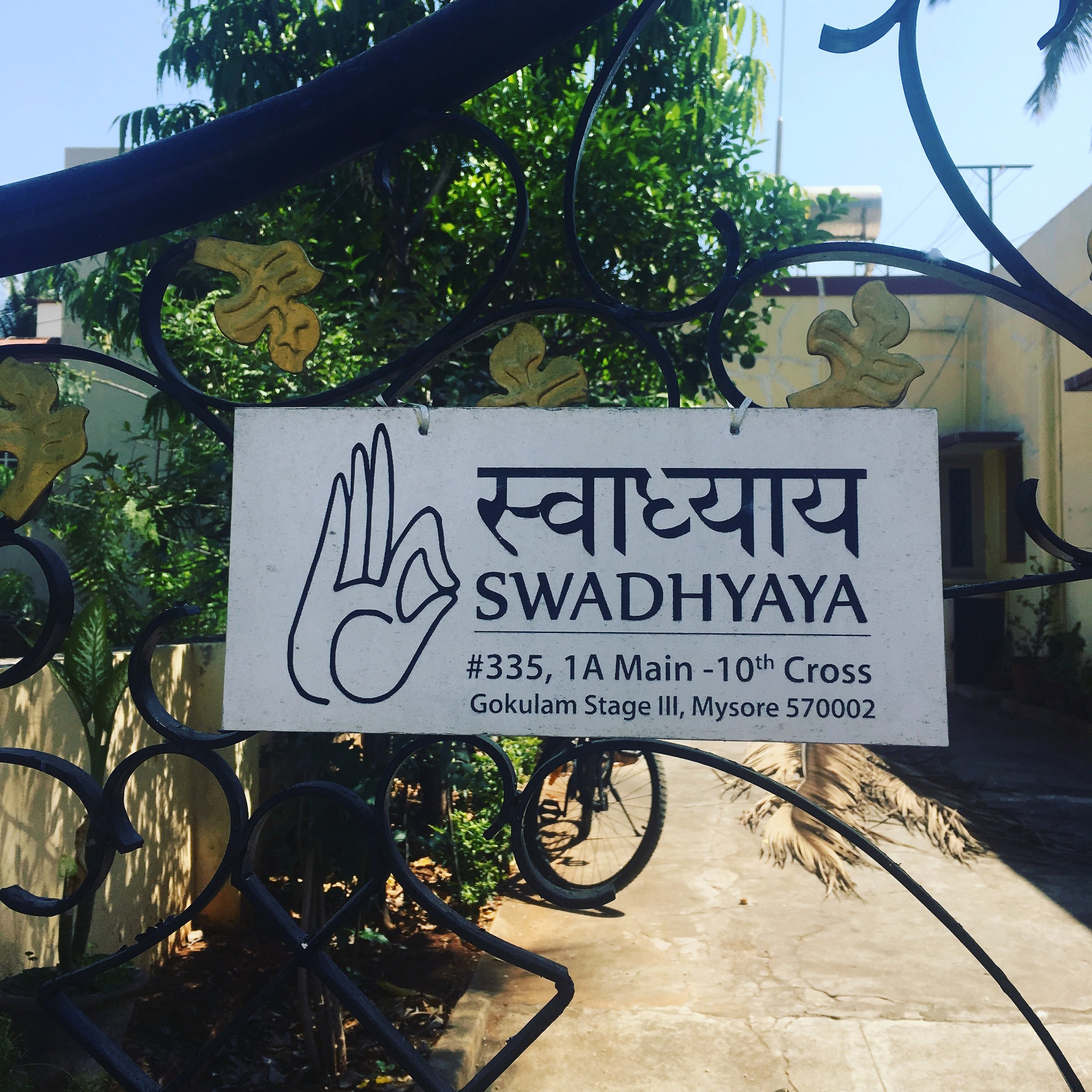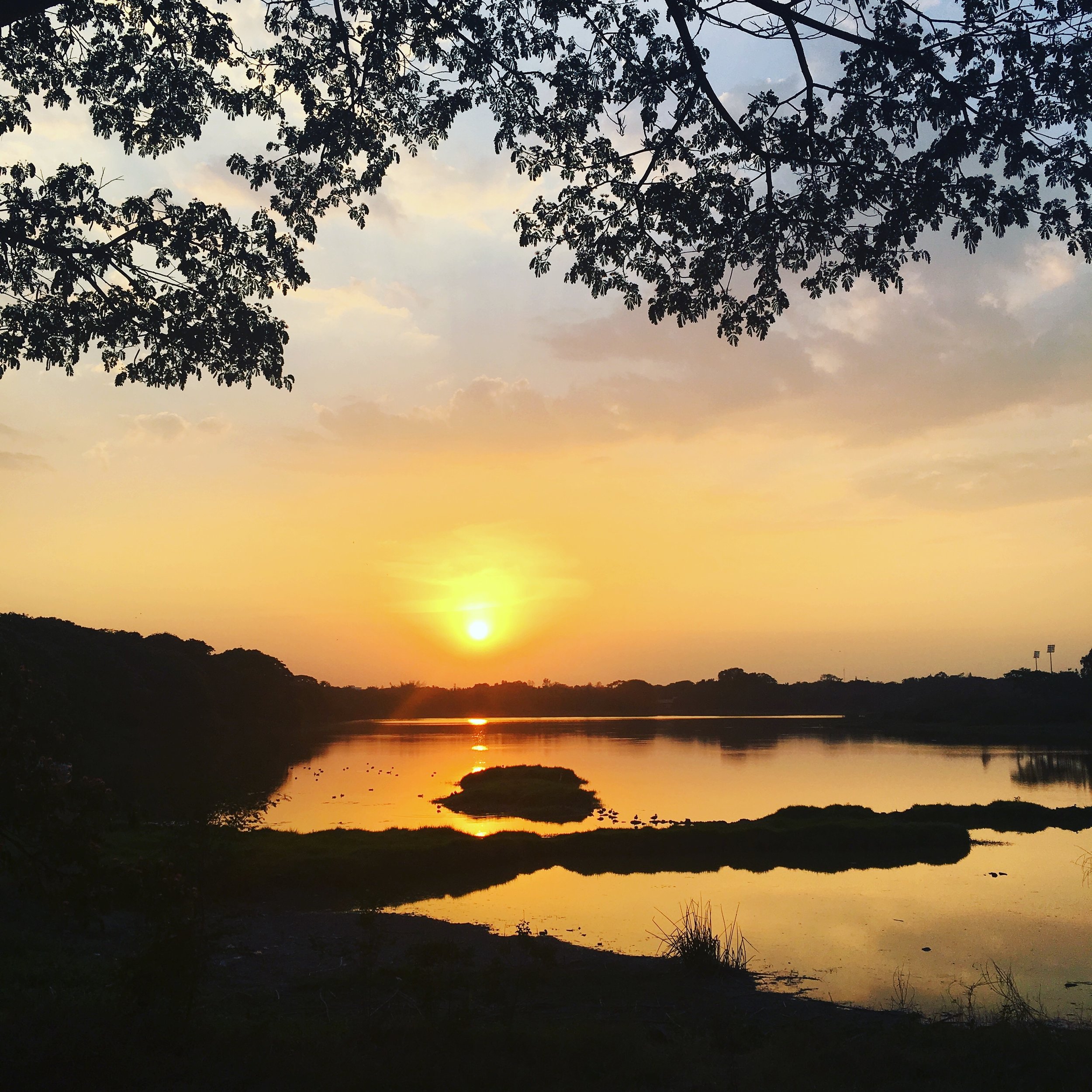Tapas in Mysore
I spent last month studying at KPJAYI in Mysore, India. I travel there once a year, to deepen my Yoga studies, practicing with my teacher, Sharathji. It was my third time there, so it seems like nothing new, but every time I come, my experience is always new in a way. Today, I wanted to share with you a little bit more about what life in Mysore was like.
Studying in Mysore is first and foremost, a practice of Tapas. I do not mean going out and eating the Spanish-style tapas…Tapas, the Sanskrit word, meaning self-discipline, making some sacrifices. It is one of the Yamas & Niyamas, Yoga’s ethical guide of living, as explained in the Yoga Sutras by Patanjali. My Yoga philosophy teacher explains tapas as learning to use one’s body and mind to go in one direction, going towards one-pointedness, towards Yoga. Tapas requires many changes to be made in the daily routine, which can really influence your lifestyle. In the beginning it can be a struggle, you might be suffering from the changes, but as time goes by, your mind and body adjusts, and you start feeling the gift of this beautiful practice. A very big part of the practice is the daily asana. Getting on your mat, no matter what, every morning, day after day. It is a lifetime practice. But tapas cannot be a forced discipline, it needs to come in a natural way, slow and gentle changes that lead to a new way of more conscious living.
Spending time in Mysore, allows me to really focus on my practice. Everything about this trip is about yoga, it is my number-one priority. This allows me to see what I need to work on, what I struggle with most, and how can I take this back to my daily life back home. Below, I list ways in which I felt I was developing my practice of tapas:
Asana Practice
“Practice, practice and all is coming” are one of the most famous words of K.Pattabhi Jois, the father of Ashtanga Yoga. In Mysore, everything revolves around the practice. It is one of the main topics of conversation and what most yogis constantly think and plan around. We practice 6 days a week, with Sundays off for rest day. Mondays and Saturdays we have led class, Tuesday till Friday - self practice. During registration you receive a time slot for your classes; I got 5:30 am for self-practice. This is in “shala time”, which means 15 minutes earlier than normal time, so it’s really 5:15 am. You have to arrive 30 minutes earlier than your time slot, so for me it’s 4:45 am. I think it’s all to make it slightly more complicated and add a little “Mysore magic” to figuring out what time you should set your alarm clock to.
It’s still totally dark outside, the alarm rings 4:00 am, and after spending a very hot night trying to wave mosquitos away, I am usually not at all ready to wake up. But, wake up I must, so the day starts. Shower, then something to drink. Later, I take a moment to do a sitting meditation, followed by simple kriya - cleansing techniques, and pranayama - the breathing techniques. This practice helps me wake up and get my body working. At 4:38, I leave, as the shala is just down the road, so it only takes a moment to get there. On my first day of practice, it turned out the gate to my building was locked, so after panicking for a few minutes, I decided to climb over it, which was not as easy as I had thought… The very short walk to the shala was the most peaceful moment of the whole day, passing the sleeping dogs, watching the stars above me and feeling the cool breeze on my face.
Practicing in the old shala in Mysore is one of the most amazing parts of the whole trip. This special space, where all the dedicated students come together from all around the world. There is an energy you can feel in the room. It changes how you feel, how you move and breathe. This energy, together with the heat of the room, can bring some amazing changes in your practice. Despite the many distractions, despite so many people practicing right next to me, I always feel remarkably calm. I feel only the rhythm of my steady breath and my body moving with it. Each year, my practice is a bit different, I work through different challenges. It’s always a new lesson in some way, where I learn something I didn’t know about myself.
Yogis need to be really dedicated to their practice, most importantly showing up on their mat, every day, always. Unless, of course, you have an injury, as then you need to respect your body. If an injury does occur, we can either modify the practice in such a way to allow healing, or focus more on other aspects of yoga, such as pranayama, chanting and meditation. My philosophy teacher would tell us that it’s important to remember that the concern of yoga is a healthy body, not a circus body.
Practicing very early in the morning, you start noticing how other parts of your life influence how you feel on the mat. What and when you ate, how long you slept, it all makes an amazing difference. So, dedicated yogis, slowly start changing things around in order to “have a better practice” tomorrow. It seems that we are changing everything around our lives to fit into the asana practice.
Eating habits
The biggest change in my eating habits, after starting to practice yoga, was switching to a vegetarian diet. This process was very natural for me. I first removed meat and later fish from my diet, because of ethical reasons. Initially, I did not in any way connect this with practicing yoga, and it is only now, years later, that I see the connection. I started feeling mental discomfort when eating meat, and finally decided to stop altogether. Today, I eat a plant-based diet, and feel great about this decision.
Ahimsa, non-harm is the the first of the Yamas, which regulate a yogi’s relationship with the world around. A person committed to Yoga, should eat in a way which does not cause harm to our fellow beings. Becoming a vegetarian or vegan is often a choice of yogis, as it is a way of living in harmony with nature.
Already a vegetarian for the past years, I was also limiting my dairy and eggs, only eating such products on weekends, and choosing a vegan diet on weekdays. I started off this year by taking part in Veganuary, eating a vegan diet all through January. I felt great, and super light on the stomach, so I decided to continue through February to feel good before I start my practice in Mysore. Once in Mysore, the natural choice was to continue. So, I am a few months into a plant-based diet and feel very healthy and, most importantly, comfortable with the moral choice of what is on my plate.
Once I started practice in Mysore, I also concentrated on allowing myself 12 hours time after my last meal, before next day’s practice. Naturally, I had some mishaps, but generally kept to this schedule, also not eating directly after practice, but about 1 hour later. I noticed that in a natural way I started following the intermittent fasting idea, and it just worked so well for me. On most days, I ate for 8 hours, and fasted for 16. I really felt much lighter once finally on the mat, and my practice, together with the heat and energy of the shala changed drastically for the better.
Once I got back home, I really wanted to keep at this schedule. I continued on with my plant based diet, but the 8-16 routine has not been easy at all. I often have evening classes, and don’t get home until very late, feeling really hungry. So, I am working on how I can modify this routine, to fit into my much busier schedule, but to still feel great when I am on my mat.
Sleeping habits
Sleeping habits in Mysore can be a bit of a struggle. I could sleep until 4 on most days, so it was not as bad as some other students, who started practice at 3 am… So, most importantly I focused on trying to have 8 hours sleep, which with the heat and mosquitos did not always work. In theory, I tried to go to sleep around 8pm, which was a bit of a struggle to get used to. It usually ended up to be later, and only to be woken up by the sound of a mosquito, just moments later. Due to not enough sleep at night, I would try to find some time during my day for a short nap, so I could keep my energy. I must say that I struggled quite a bit with getting my sleeping patterns to work on this trip.
When I am at home, I also try to keep to 8 hours of sleep during the night, if possible. I usually wake up 5 or 5:30 am in London, so going to sleep early is a part of my life. It is hardest on the days when I get home late from my evening classes, and this really messes up my routine; on the next day I also aim to find a moment even if for just a short nap.
Socialising
As you see, yogis in Mysore can be a bit of a bore… We pretty much don’t eat dinner, go to sleep super early, want to find some alone time for meditation and studies, so socialising can be a bit limited. But, there is always the Sunday and Moon-days off to take rest, go to the pool or on a trip out of the city. Yoga students often go out for a nice dinner, and even some drinks or the occasional party, on the night before a moon day, as we can sleep in on the next day. We often meet for breakfast or lunch during the week and almost always chat after practice, during the morning fresh coconut water. There is a special coconut stand in front of the shala, for students to get their coconut water right after practice. It’s a perfect time to catch up with friends. Unless you’re not able to speak to anyone, because of a very deep back bend you just did…
Screen time
Many of us spend too much time during the day in front of the screen. It’s hard to limit this when you are working, but we can try to limit our social media time. I decided to try to cut down on using Instagram, where I am usually active. So, I was a bit quiet on my account, just showing little bits and pieces in stories, mostly. I also focused on cutting down on my screen time in the evening, which really influence our sleeping patterns. So, I opted for a good read on my kindle before nodding off.
Pranayama, meditation & chanting
For the past years, together with my asana practice I started developing my pranayama practice. Pranayama are breathing techniques, that help us be in control of our breath, which leads to control of our mind. There are many different techniques, that all allow the practitioner to feel centered, more in the present moment. Using these techniques you can find stillness in the mind, quieting the thoughts. I aim to have a daily Pranayama practice, but my time is always limited. So, I just choose a few techniques that I practice, concentrating just on these. During my stay in India, I had much more time to myself than ever. I decided that, every day I will find time either after my asana practice or in the evening to focus only on my pranayama and meditation. My favourite place and time was right after morning asana practice. I would come up on my rooftop to watch the sunrise and it was the perfect moment just to be present, feel grateful, find my own way of meditation. Pranayama can be used as a way to meditate, or as an introduction to one’s meditation, as I learned to use it.
Chanting Vedic mantras is a large part of the yoga tradition. You do not need to be religious to chant mantras. Again it is a way to be present, to focus on the sounds and vibrations, but also on the meaning of each mantra. Mantras are always chanted in Sanscrit, and learnt by heart. Chanting is a large part of studying at KPJAYI, there is a special class 3 times a week. It is a beautiful way to come together as students and feel the energy of this practice together.
Svadhyaya
Svadhyaya means self-study. It is taking time to search for the meaning of yoga, of what it can mean in your own life. Svadhyaya can be understood as reading books on yoga, learning with a philosophy teacher and doing your own meditation.
When I started practicing yoga many years ago, I had no idea about the beautiful philosophy behind it and how much I would relate to it. It is very important to find your own teacher who can guide you in your journey. I had to search for a teacher who could explain yoga philosophy in a way that I could really relate to. The first time I started studying yogic texts, I felt they were such far-fetched ideas, it was very difficult to relate to them and see what this really has to do with my life. I didn’t know I could bring this philosophy into my daily routines. I am very happy to have found my teacher in Mysore. It is the second year I am studying with him, we had daily classes from Monday to Friday. Sometimes it was hard to focus when it was almost 40 degrees Celsius outside, but Arvind, my teacher, had such a way of speaking with a great sense of humor that he always kept us on our toes.
I am really excited, because Arvind is planning to start online video classes to allow his students to continue their studies after leaving Mysore. I can’t wait!
I also took time to self-study not only the philosophy, but also take a closer look on the biological part of the physical asana practice. As a teacher and student it’s very important to understand the body and how it works in the asanas, knowing about possible injuries, how to work with them, how to modify. I had the opportunity to take part in an amazing anatomy course with a really great teacher in Mysore. This is something I try to work on constantly, broadening my knowledge about this practice.
How can I take this tapas practice home?
So now, here is the hardest question of all. How can I? It was much easier to practice tapas when I was by myself in a world focused on Yoga, but how can I find all this in my busy everyday life in London? I am writing this post partly for myself, so that I can find this answer. The truth is that I cannot take everything back, it’s just impossible. After my return, there is always so much going on, so much happening, my schedule is complicated with classes starting early morning and on some days finishing really late in the evening. So, I have to take a look at each part of my tapas practice and see what is realistic, what I can commit to daily. I think that the most important part is to keep trying, doing the best I can and to keep reminding myself what I am working on.




